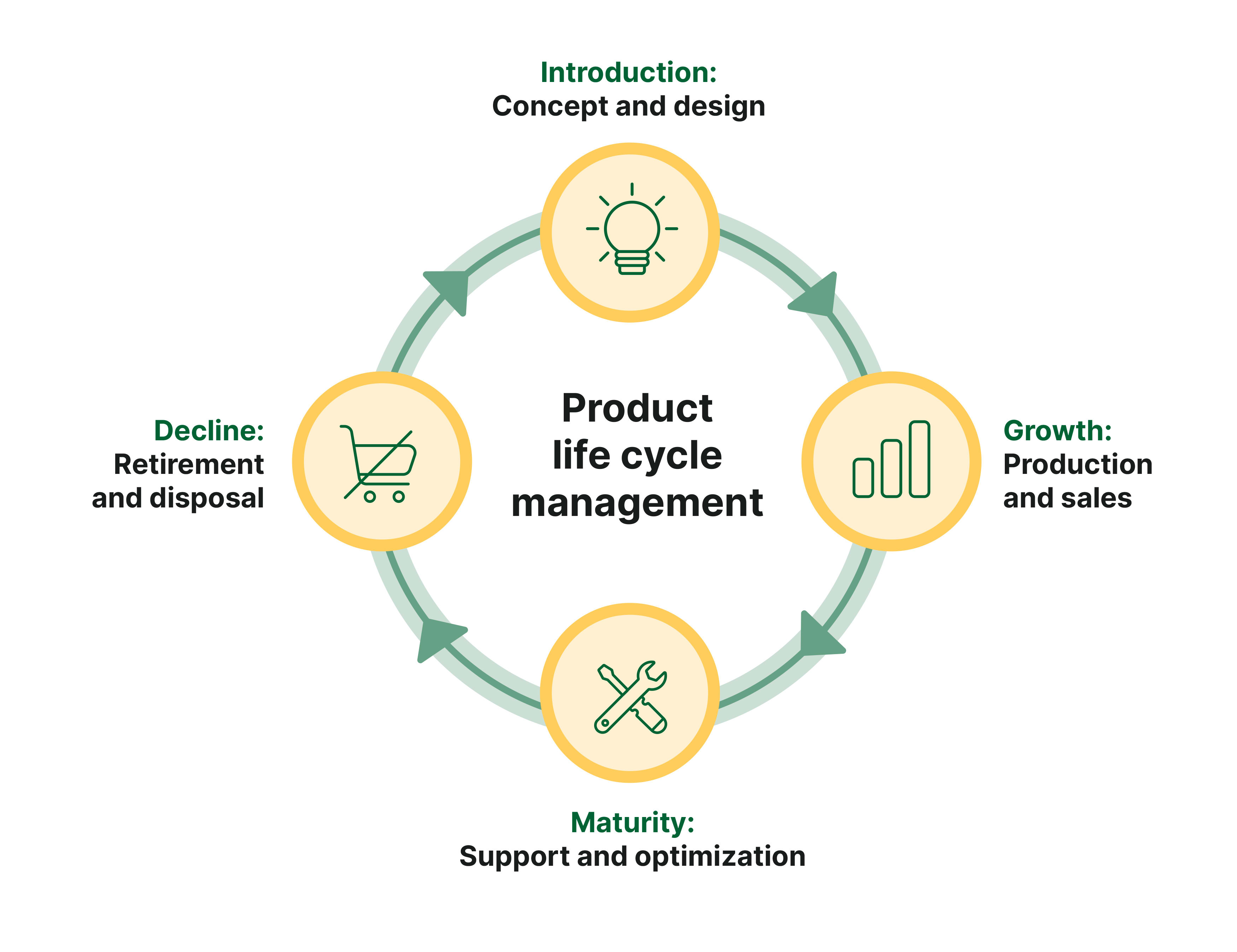Guide to product life cycle management (PLM)
Learn the importance of PLM for modern businesses, strategies for effective PLM and how digital asset management supports the entire product life cycle.
Learn the importance of PLM for modern businesses, strategies for effective PLM and how digital asset management supports the entire product life cycle.
As the pace of product development continues to accelerate, companies are under immense pressure to innovate and deliver quality products in a fast, consistent and cost-effective way. This is where product life cycle management (PLM) comes into play.
For product teams and business leaders, understanding and harnessing the power of PLM can mean the difference between poor market performance and competitive success.
In this guide, we cover everything you need to know about PLM to help you effectively manage and optimize all aspects of your product's journey.
PLM is a systematic approach to managing the full lifetime of a product. Starting with a product's inception, PLM tracks and manages the product throughout its life cycle until it is retired from the market. This includes product development, production, sales, support and disposal.
Since its introduction in the 1990s, PLM has evolved from a strictly engineering-based process into a comprehensive strategic framework, often involving multiple departments within an organization.
PLM is an essential tool for businesses seeking to improve product quality, reduce time-to-market and increase operational efficiency. It aims to extract the maximum value from products at every stage, ensuring they meet market demands while fulfilling strategic business objectives.
PLM is not to be confused with project portfolio management (PPM). While they are both crucial components of product management, their focus and goals are different.
PPM involves managing a full portfolio of products, projects and programs to ensure the best allocation of resources and alignment with business goals. PLM, on the other hand, is concerned with the entire life cycle of a single product and all its associated processes.
By implementing PLM strategies, companies can bring products to market more efficiently and effectively, ensure customer satisfaction throughout the product life cycle and maximize profitability.
Implementing a robust PLM system is essential for modern businesses. It offers a host of benefits to product developers, marketing teams and organizations as a whole.
Improved product quality and innovation
PLM strategies and systems facilitate better control over product design and prototyping, ensuring the end result aligns with both customer expectations and business goals. Through comprehensive tracking and data analysis, companies can identify issues early in the product life cycle and make informed decisions for improvements.
Reduced time-to-market
Through streamlined processes and optimized resource allocation, PLM enables swift transitions from ideation to production, shortening the time required to introduce new products to the market.
Enhanced collaboration and communication
A well-deployed PLM strategy fosters seamless collaboration, allowing cross-functional teams to work together efficiently. This environment helps teams reduce errors, make quicker decisions and communicate more effectively across the organization.
Increased operational efficiency
PLM helps eliminate redundancies and unnecessary steps in the product development process, leading to improved operational efficiency, reduced costs and a leaner operation. With the right information management system, product teams can easily access all product-related information in a centralized way, streamlining workflows and minimizing errors.
Better cost management
By providing a comprehensive view of all product life cycle costs, PLM allows for better cost management during development and more competitive pricing both during and after product launch. This visibility also helps identify areas for cost savings and optimization when planning for product improvements, compliance needs and other market changes.

Nuxeo Platform’s DAM offering was named a Leader in the DAM space in Omdia’s 2023 report. Our solution achieves the maximum score for advanced capabilities and solution breadth, and Omdia places our market momentum as above average for the field.
To leverage PLM effectively, there are three critical pillars organizations need to focus on:
PLM relies on accurate product data throughout the entire product life cycle to ensure consistency across departments. For this reason, a PIM system is essential to support PLM strategies.
A comprehensive PIM solution allows for centralized management of all product-related information. This includes everything from product specifications and designs to supplier information and maintenance records.
Streamlining and optimizing the product development process within a PLM system can significantly improve efficiency. When processes are well-defined, teams can work together more effectively, minimizing delays and errors.
Process management also allows for better tracking and reporting, leading to more informed decision-making.
Successful PLM relies on the active participation and collaboration of individuals across the organization.
Cross-departmental efforts help break down silos and foster a more integrated, efficient workflow. This collaboration is essential during all stages of the product life cycle and requires effective communication tools and a culture that values teamwork.

To fully understand the role of PLM and how to implement it effectively, it is necessary to examine the different stages that products go through in their life cycle.
Each stage presents unique challenges and strategic opportunities:
The primary goal at this early stage is to create a concept that resonates with customers and can be feasibly manufactured, distributed and sold. During this stage, product teams focus on ideation, market research and design, followed by a launch strategy.
As the product is introduced to the market, the growth stage is characterized by increased consumer demand and the need to ramp up production. Product teams must ensure efficient production processes and effective marketing strategies to increase market share and reinforce the product's competitive position.
At this stage, the product has secured market share, and the focus shifts to providing support and managing competition. Teams must optimize processes to decrease production costs, explore product extensions and focus on customer retention.
The final stage of a product's life cycle focuses on extracting the most value from retirement and disposal. As sales decline, teams must make end-of-life decisions, cut costs and develop plans to leverage the product's retirement in a strategic way — for example, in support of a new product launch.
One of the most significant advantages of PLM is its ability to help product teams make data-driven decisions throughout the product life cycle.

By using evidence-based metrics to guide product transitions between life cycle stages, teams can make more informed decisions about when to invest resources in a product and when to retire it.
Here are four key metric groups to consider:
Understanding market demand is crucial for successful product management. Regular market research, trend analysis and competitor monitoring can provide insight into current and future demand for a product.
Key metrics to track include:
Tools like Google Trends and market research reports can offer valuable data on these metrics. By analyzing this data, companies can identify potential market gaps and opportunities for product improvement as well as gain insights into consumer needs to inform their product strategies.
Measuring sales performance can reveal the effectiveness of marketing strategies and highlight opportunities for increased market penetration. This data can also help identify future trends and potential issues with the product or its pricing.
Key metrics to track include:
Companies can leverage customer relationship management (CRM) systems and sales automation tools to monitor and analyze these metrics. With this data, teams can make informed decisions about product pricing, marketing strategies and customer retention initiatives.
Staying connected to customers is essential for improving products and building strong customer relationships. Gathering feedback through surveys, online reviews and social media can provide valuable insight into customer satisfaction levels, common complaints or issues and recommendations for improvements.
Key metrics to track include:
Incorporating customer feedback into PLM strategies can help teams make customer-centric decisions and enhance the overall product experience. It can even turn satisfied customers into brand advocates who promote the product to others.
Efficiency metrics provide insights into the effectiveness of production processes, resource utilization and overall operational performance. By tracking these metrics, companies can identify areas for improvement and implement strategies to reduce waste and costs, speed up production and increase profitability.
Key metrics to track include:
Tools such as enterprise resource planning (ERP) systems and process mapping software can help track and analyze these metrics. By identifying areas for optimization, organizations can improve their bottom line and create a more sustainable and efficient operation.

Drawing on insights from 3,000 European decision-makers, this report offers a framework for IT leaders to uncover challenges and accelerate progress in key technology areas such as cloud, automation, AI and content services.
As technology advances and market demands shift, the role of PLM will continue to evolve.
Some key trends that are redefining how companies approach PLM include:
In the coming years, we can expect to see more new tools and strategies emerge that will enhance the product life cycle management experience. Technologies like artificial intelligence, machine learning and Internet of Things (IoT) devices will play an especially significant role in optimizing processes and data analysis.
As these technologies continue to mature, companies that embrace them in their PLM strategies will have a competitive edge in the market.
Digital asset management (DAM) is another essential component of PLM. In today's digital age, managing product assets such as images, videos and documents is crucial for effective product development and marketing.
Modern DAM software allows companies to manage, store and share these digital assets in a streamlined and collaborative way. By integrating DAM with PLM systems, companies can reap even more benefits such as:
Explore the capabilities of Hyland’s Nuxeo Platform, which offers a powerful, flexible and scalable DAM solution that integrates with PLM systems to support the entire product life cycle. See key DAM features in action in our playlist of short demo videos below.

Uncover the fundamentals, functions and benefits of DAM systems to optimize your digital workflows and elevate your organization's asset management strategy.

If you want your creative teams to produce their best work, then they need instant access to digital assets. But providing access to these materials is easier said than done.
Not only do you need a centralized digital asset management system (DAM), but you also need a streamlined DAM taxonomy that classifies assets in a way that your users can understand. But what exactly is a DAM taxonomy?

Managing your assets in the cloud keeps you well positioned to meet the growing demands for content.

Explore how a successful DAM implementation enhances efficiency, streamlines workflows and unlocks the full potential of your digital assets.